
Ecommerce has made shopping a seamless experience. Instead of driving miles to check out a new store, discovering brands is as simple as scrolling Instagram or clicking a link.
That easy-to-use experience is also why we use referral links at ReferralCandy. If new customers find it easy to shop, they’ll be more likely to make purchases.
We’ll share more about the various features we’ve embedded within our referral links, and the advantages of referral links over coupons or alternatives.
But like the customer journey of a referred friend, it all starts with a referral link:
A referral link is a unique URL generated as part of a referral program. The referral link helps ensure the referral rewards are paid out and provides additional data for your marketing efforts.
Let’s say you run a referral program for your Shopify store.
This can all be done automatically, without any manual tracking on your end. Easy!
Let’s take a look at how ReferralCandy creates a personalized referral link for each of your customers.
ReferralCandy creates a referral link from a combination of two parts; a store subdomain and a customer URL.
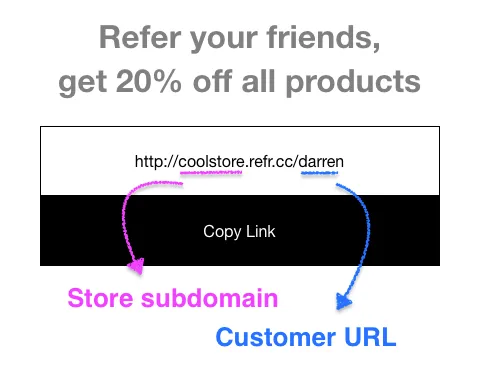
The Referral Program Unique Subdomain is a vanity URL that redirects customers to your store, which you can customize to your liking in your Store Settings:

The customer URL portion of the referral link is auto-generated from a combination of the customer’s first name, last name, and email address. Your customers can also customize this part of the URL in the referral portal.
In terms of technology, the referral link embeds important information about:
After clicking the referral link, the referred friend will reach a friend offer landing page with a referral code, the name of the advocate that referred them, and the value of the discount.

When they click Shop now, they’ll be redirected to your store to start shopping right away. Plus, if you’re running a Shopify or BigCommerce store, the discount will be automatically applied at checkout.
ReferralCandy also drops a cookie that lasts for 30 days. Online shoppers tend to comparison-shop, browsing several different stores in several different steps. Even if the new customer hesitates, browses away, or is distracted, they can still return within 30 days to claim the friend offer discount on their purchase.
This happens more and more, as people browse and shop on multiple devices.
Once a valid purchase is made, ReferralCandy validates the transaction and reviews it for referral fraud, then automatically pays out so your existing customers will receive their referral rewards.
Here’s how existing customers find their referral links.
After every purchase, your customers will be prompted to join your referral program (if they haven’t already). The prompt can come in the form of a post-purchase pop-up widget or a post-purchase email that might look something like this, from Riff Raff & Co:
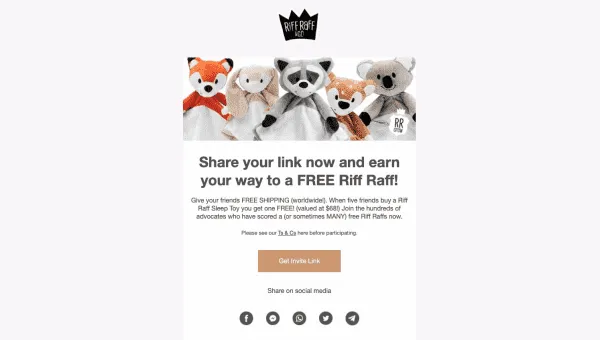
You may also like: 20 examples of beautiful email referral design
They’ll be brought to a landing page where they can create an account:
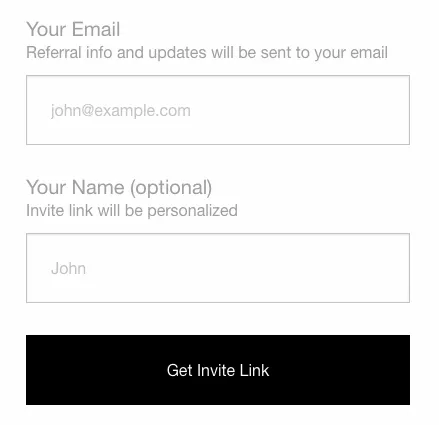
When they click Get Invite Link, they’ll receive their referral link. However, they can also log in to the referral portal to edit the referral link like so:

They’ll then be prompted to share their referral link, either as a URL or through social sharing and messenger apps, like Facebook and Twitter, or Messenger, WhatsApp, and Telegram.
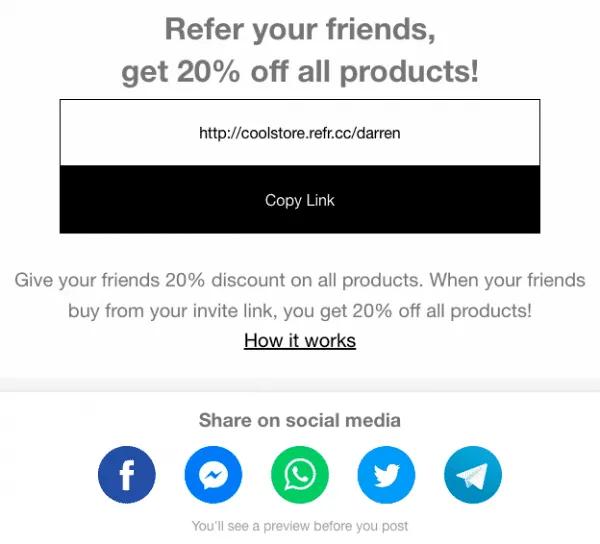
Sharp-eyed readers may have spotted that the friend offer landing page actually contains a referral code that can be entered at checkout like any other promotional or discount code.
You might be wondering: why does ReferralCandy prefer to use referral links?
For the customer, a referral link is easier to use. When they click on the referral link, the coupon is automatically applied during checkout. Customers can click, shop and checkout without any additional steps.
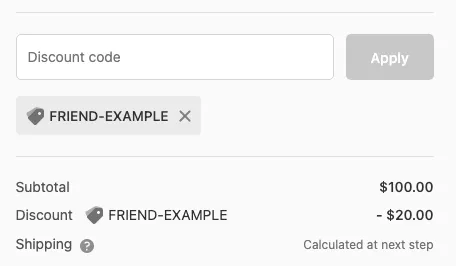
This applies to Shopify and BigCommerce stores only
This is a much smoother experience than the customer who, after browsing, has to fill in payment information and also copy-and-paste the discount code from their email — something that tools like an email debugger can help streamline and optimize.
Cart abandonment is a real problem in ecommerce, and anything that makes checkout smoother will definitely help conversion rates.
We also drop a cookie that lasts for 30 days. Customers tend to browse on different devices and shop on different tabs before making a purchase; the cookie gives them a second chance to buy and complete the referred purchase.
Customers use referral links at the start of the shopping experience; they use referral codes at the end, during checkout. Using referral links helps generate tracking data from the moment they land, which is useful for marketing attribution.
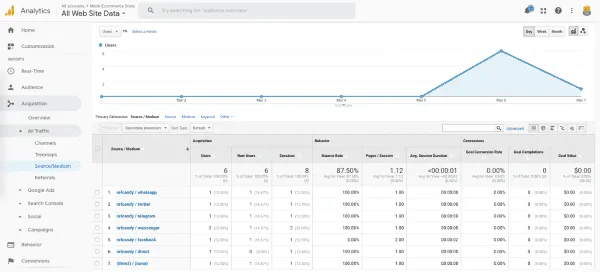
Tracking visitors from ReferralCandy to your store using Google Analytics
You’ll be able to see how and where your customers are sharing their referral links. In Google Analytics, visitors from referral links have a custom source tag [“refcandy”] followed by the medium.
This can give you some indication of the most popular social media networks or messaging apps your customers prefer to use.
When new customers click on a referral link, they are shown the friend offer landing page before being redirected to the store. This is important, and ensures that the new customer gets a chance to see the referral incentive.
Without this interstitial, the customer may be distracted by other discounts on your site, like a discount for subscribing to your newsletter and miss out on completing the referral.
Using the referral link also means that the tedious business of tracking referrals and sales is automated by the ReferralCandy app. You won’t need to manually enter details into spreadsheets or check how many times a discount code is used.
This automation allows ReferralCandy to send referral rewards to existing customers automatically. Your customers deserve their rewards for referring a friend and may become frustrated or angry if they don’t receive their reward.
Using the referral link simplifies this situation, and ensures that the loyal customers playing advocate get their referral rewards.
Without the tracking provided by the referral link, it can be difficult to accurately attribute purchases and referrals.
The referral link is also harder to fake or spoof. Some customers are savvy and will try commonly-used discount codes like ‘NEW15’ or ‘SALE20’ on every store. Using a referral link prevents situations like this.
Since each referral link is personalized to each customer, you’ll be able to track referral abuse or fraud. If a coupon code is exposed on a coupon site or used too many times, you’ll be able to match it to the customer in ReferralCandy’s fraud centre feature in the future and take remedial action like banning the advocate. This can help eliminate referral fraud and abuse.
One of the major benefits of a referral program app is the ability to capture referral data. Using a referral link pipes the data directly into ReferralCandy’s dashboards:

From our dashboard, you’ll be able to evaluate the success of your referral program and quantify the revenue generated. This automatic report eliminates the need for tedious manual data entry into spreadsheets.
The friend offer landing page also serves another purpose as an interstitial: you can embed custom tracking pixels for retargeting ads.

Currently, you’re able to embed pixels for Google Ads, Facebook, and Adroll. This allows you to increase the ROI of your ads by retargeting the leads customers already bring you.
If you use Klaviyo or Mailchimp, you’ll be able to embed the referral link directly into any emails or newsletters you send to customers. This means that you can promote your referral links in your weekly customer newsletter, or as part of your post-purchase transactional emails as well.
For Mailchimp, it’s a merge tag you can paste directly into the content of the email:

Read more: ReferralCandy x Mailchimp integration
For Klaviyo, you can insert the referral link as a custom property. You can also insert the value of the friend offer and referral reward as custom properties as well.
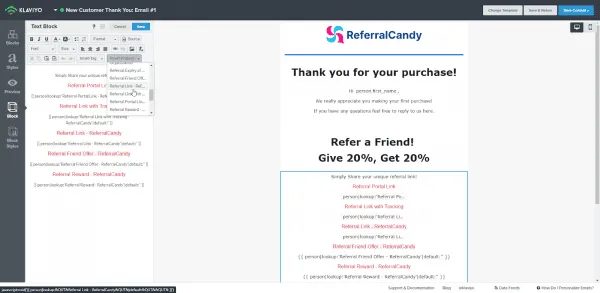
Read more: ReferralCandy x Klaviyo integration
Being able to track and attribute purchases and referrals is important for the success of your referral program. You now also have a perspective on why we use referral links for ReferralCandy and all the other benefits of using referral links over referral codes or coupons.
You may also want to look at the following resources:
And also, sign up for our newsletter for more ecommerce insights and trends.
Darren is a content/SEO writer and product marketer. He doubled search traffic for the blog and put ReferralCandy on the front page of the Shopify AppStore.
Grow your sales at a ridiculously
lower CAC.